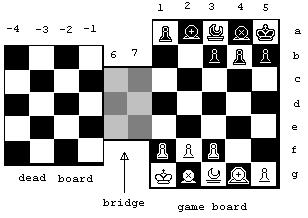Pagan Chess
By Mikey Kousre
Introduction
Pagan Chess is just a little game that I came up with. It is very strategic, and you have to think out your moves before you make them. Many times I've taken my hand off a piece and smacked myself in the forehead in disappointment.The Boards

|
|
The first is the game board. The game board is a 5x7 section. It is the one where the pieces start, all of the pieces in this board are considered alive.
The bridge is a 2x6 section of the board connecting the game board to the dead board. The bridge should be colored gray (or some other color different from the rest of the board) to distinguish it from the rest of the boards. No piece may actually land on a bridge square, although the Pagan can move over them.
The dead board is a 4x5 section, all of the pieces on this board are considered dead.
The Pieces
There are five types of pieces in Pagan chess. The King, the Alchemist, the Pagan [or Wizard], the Wazir, and the Pawn. All of the pieces have the unusual ability of reincarnation. If any of the pieces is captured, it is placed on the dead board, in the empty space closest the bridge, and near their starting side. For example if a White piece captured, it would be placed on f-1 if was empty, and if not f-2 if that square was empty, continuing on to the next row [e-1, e-2] if necessary. Pieces are free to make capturing moves on the dead board, and a piece captured on the dead board is removed from the game.The King is moves as a King in Western Chess, moving one space orthogonally, or diagonally, but does not castle. On the game board, the King can be captured and sent to the dead board like any other piece, but not by the opposing King. Once on the dead board, the King is not captured, but rather checkmated as in Western Chess.
The Wazir moves as a modified Wazir (or short Rook), and slides one or two spaces orthogonally.
The Alchemist moves as combination of a Ferz and Alfil. It moves one step diagonally or leaps two spaces diagonally (possibly leaping over a intervening piece).
The Pawn moves as a modified Western Chess Pawn. There is no initial double move. The pawn only promotes on the squares that the opposing royal pieces [the King, the Wazir, the Pagan, and the Alchamest] initially occupy. [g1 - g4, and a2 - a5] It captures sideways, on either horizontally adjacent square, instead of diagonally forward. If a Pawn reaches the far side of the dead board, it is stuck, unable to move; it may still capture, of course.
The Pagan is the most powerful piece in the game. It moves as a short Orthochess Queen -- one or two spaces orthogonally, or diagonally. The Pagan attacks as a Withdrawer. It must be in an adjacent square to the piece it is withdrawing from, and then must move away at least one space directly away from the piece to capture it. The Pagan also has the ability to "cross the bridge". This means that it can both go onto the dead board without being captured, and leave it after being killed. The Pagan is the only piece that may cross the bridge.
The Object
The object of the game is to mate the opposing King on the dead board. If both Kings are bared, the game is a tie.Strategy
The only advice I can really give is think before you move. Like I said before I have hit myself so many times in the head. There isn't a lot of room on those boards you just have to watch where you're going.Also, the Pagan is an immensely powerful piece in this game. Use it wisely.
Written by Mikey Kousre.
WWW page created: May 27th, 2003.
